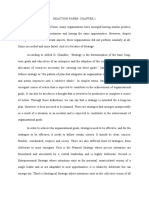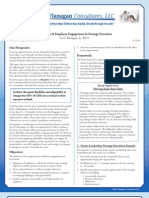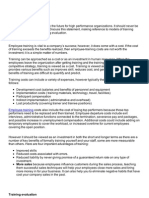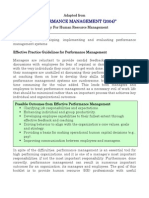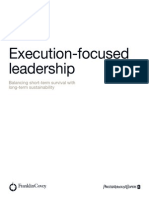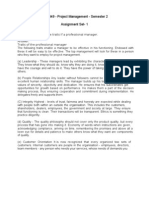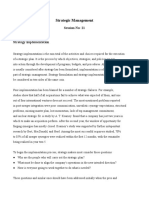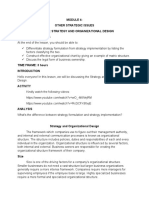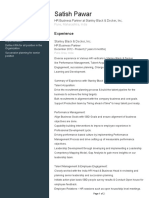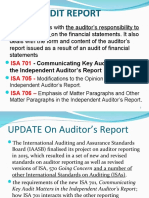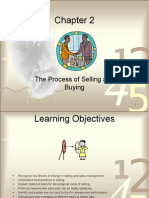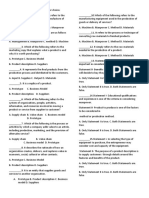The Process of Leadership
The Process of Leadership
Uploaded by
ratihaleaCopyright:
Available Formats
The Process of Leadership
The Process of Leadership
Uploaded by
ratihaleaOriginal Title
Copyright
Available Formats
Share this document
Did you find this document useful?
Is this content inappropriate?
Copyright:
Available Formats
The Process of Leadership
The Process of Leadership
Uploaded by
ratihaleaCopyright:
Available Formats
THE PROCESS OF LEADERSHIP
leadership is not a role, it's a process involving how an individual or a group influences others toward a particular goal or objective. Leadership development occurs across one's life span. Some people qualify that process, and what it means by adding words like inspiring leadership or directive leadership. I look at it as a social-influence process. Many leadership development programs don't come close to what life does to produce outstanding leaders. So one of the most important elements on leadership development is the focus to take on sustaining the development experience over an extended period of time, keeping in mind our impact points on performance. There are five essential steps include of the leadership process: Step 1: Leadership Orientation and Commitment Leadership orientation and commitment is normally a one to two-day orientation session in which key leaders from the organization learn about High Performance. In this session participants go through an organization simulation to experience the difference between traditional and High Performance work systems. As they learn and discuss principles of High Performance, they will learn about the transformation process, explore the level of trust within the organization, and identify change needs driving their organization. Step 2: Assessment of The Business and Organization The purpose of this step is to complete a comprehensive assessment of the organization, creating a common understanding of the current state of the business. Key leadership, with a cross-section of people from the organization, analyzes a business case study to learn how to use the Transformation Model as a framework for organization analysis. Then, applying the Transformation Model to their own organization, they systematically analyze seven key elements: current results; the business environment; the current strategy; current core processes, current structure; and coordination and development systems. Following their analysis, they summarize key issues to address and identify organization strengths, weaknesses, and alignment issues. Armed with comprehensive assessment data, they can develop a list of change initiatives for improving the organization and moving toward High Performance. The assessment process can be modularized into half-day sessions spread over a nine to ten week period, or it can be accomplished more quickly in a single three-day session. This step often surfaces significant problems within the organization, creating a sense of direction and momentum for needed changes. Every participant will come away from this dynamic session with a greater sense of responsibility, know-how, and enthusiasm for making the business succeed.
Step 3: Development of Strategy and Vision In step three, key leaders develop and/or adjust the business strategy and direction of the organization. During this process they review their strategy and vision based on current business realities, refocusing and redefining their strategy to fit marketplace and competitive demands. Specifically they will accomplish the following during the process: 1. Understand the demands of the current business environment; 2. Forecast the future business situation 3. Clarify a mission that motivates and inspires 4. Identify the principles by which people will conduct themselves 5. Define future customers and how they will deliver value to them 6. Identify core competencies needed to succeed in the long run 7. Create a long-term business focus and identify anchors that distinguish them from competitors 8. Set short-term performance goals 9. Identify performance initiatives and establish a master plan to implement the strategy The strategy development process often requires several in-depth exploration and discussion sessions which may be accomplished over a period of weeks or months, depending on the size, motivation, and complexity of the organization. Clearly, the process must be tailored to the individual needs of each organization. We are confident that senior leadership will emerge from the strategy development sessions being very clear about their strategy and united in their commitment to implement it throughout the organization. Step 4: Chartering The Change Process During this step, senior leadership determines the need for organization redesign to address organization weaknesses and alignment issues identified during assessment. They create a design charter, outlining the expected outcomes and the scope and parameters of the redesign process. They assign resources, establish time frames, and identify a design team to participate in and guide in-depth process analysis and redesign of the organization as necessary. They also determine the scope of the development process, identifying leadership training, employee orientation, team development, technical skills development, interpersonal skills development, and other projected training and development needs. These plans are factored in with strategic initiatives and change opportunities identified during strategy development and assessment to create an overall change plan. The charter is then shared with employees to communicate the need for change and explain how the transformation process will work throughout the organization. Step 5: Integrated Management of Business
Management of business performance, especially in todays complex and rapidly changing environment, can be extremely challenging. Consequently, management behavior can be shortterm and crisis-oriented. Managers and supervisors alike often react to demands which seem urgent, but may only be symptoms of deeper causes related to flawed processes or systems. A further problem is that work may be segmented into functional areas, promoting poor communication, turf battles, lack of problem ownership, and general inefficiency. In step five, Integrated Management of Business Performance, leaders develop a common plan and establish management processes to proactively manage the short and long-term performance of the business. One of the first tasks here is to help leaders begin to work as a team as they share responsibility for the overall management of the enterprise. During assessment, the organization identified key results areas and current performance in those areas. During strategy development, the leaders identified ideal key results areas, how they will measure them, and what their goals are. Armed with this data, the leadership team outlines a process for how they will monitor, track, and integrate performance throughout the organization on an ongoing basis, including common initiatives, clear expectations, and consistent performance metrics. This may lead them into discussion or readjustment of recognition, reward, or performance management systems as well.
You might also like
- BSBLDR811 SampleDocument22 pagesBSBLDR811 SampleIrtaqa Raza100% (1)
- SQM Nugrain Arvi Allan Paul Wm80Document4 pagesSQM Nugrain Arvi Allan Paul Wm80allanNo ratings yet
- Internal Audit ReportsDocument35 pagesInternal Audit ReportsCQMS 5S Division84% (19)
- How To Get To $10M in ARR and Beyond Book (Notion Capital Foreword)Document162 pagesHow To Get To $10M in ARR and Beyond Book (Notion Capital Foreword)Abeed100% (2)
- Reaction Paper Chapter 1Document4 pagesReaction Paper Chapter 1angel100% (4)
- Mckinsey 7sDocument15 pagesMckinsey 7sManimaranNo ratings yet
- Case Chapter 15 - Nugraheni Vita Dyana - 041724353022Document6 pagesCase Chapter 15 - Nugraheni Vita Dyana - 041724353022vidia2000No ratings yet
- Brand Platform WorksheetDocument3 pagesBrand Platform WorksheetMuhammad Bilal Khawaja100% (1)
- The Leadership ProcessDocument15 pagesThe Leadership ProcessUsmanAhmedNo ratings yet
- The Development Process: Step #1: Senior Leadership Team DevelopmentDocument4 pagesThe Development Process: Step #1: Senior Leadership Team DevelopmentZohaib ChacharNo ratings yet
- Organization Development - E1Document11 pagesOrganization Development - E1priya h.pNo ratings yet
- Module 1 2 For Strategic ManagementDocument11 pagesModule 1 2 For Strategic ManagementluisamaedacanayNo ratings yet
- ODDocument18 pagesODMeenakshi GodaraNo ratings yet
- Organization Development (1) - 1Document36 pagesOrganization Development (1) - 1Alaa Shosha 7No ratings yet
- Orginizational Change Management PDFDocument9 pagesOrginizational Change Management PDFLillian KahiuNo ratings yet
- Module - 4 - Organisaional DelopmentDocument4 pagesModule - 4 - Organisaional DelopmentGuru Nanak First Grade CollegeNo ratings yet
- 3.3 Ifraz Mohammed - 20231449 - BABHRM611 - Section 2 - Develop Performance Management ProgrammeDocument11 pages3.3 Ifraz Mohammed - 20231449 - BABHRM611 - Section 2 - Develop Performance Management ProgrammeIfraz MohammadNo ratings yet
- Organisational Theory, Structure and Design Assignment Sem 3Document12 pagesOrganisational Theory, Structure and Design Assignment Sem 3Harshit JainNo ratings yet
- LeadershipNemployeeEng ExecutionDocument3 pagesLeadershipNemployeeEng ExecutionRahul NilangekarNo ratings yet
- 01-Objectives and Scope of Performance ManagementDocument10 pages01-Objectives and Scope of Performance ManagementHastings KapalaNo ratings yet
- Leture 1&2organizational DevelopmentDocument6 pagesLeture 1&2organizational DevelopmentLiezel RamosNo ratings yet
- MS 25Document6 pagesMS 25Rajni KumariNo ratings yet
- Answer of Some HRM ActivitiesDocument6 pagesAnswer of Some HRM ActivitiesAl AminNo ratings yet
- 402 SMDocument70 pages402 SMPalem Keerthi ReddyNo ratings yet
- 7 Steps To Strategic PlanningDocument3 pages7 Steps To Strategic Planningmilk-bankNo ratings yet
- CHAPTER 17 Organizational Planning and Controlling PDFDocument6 pagesCHAPTER 17 Organizational Planning and Controlling PDFAvril CarrilloNo ratings yet
- For Final Coverage IM For HRMA20013 - HUMAN RESOURCE MANAGEMENT 1-42Document42 pagesFor Final Coverage IM For HRMA20013 - HUMAN RESOURCE MANAGEMENT 1-42simonetobeschuvanesNo ratings yet
- Performance ManagementDocument26 pagesPerformance ManagementahamdNo ratings yet
- Module 3 Performance MGMTDocument19 pagesModule 3 Performance MGMTAnonymous uxd1ydNo ratings yet
- Overview of The ProjectDocument6 pagesOverview of The ProjectMoin UddinNo ratings yet
- Strategic Management MODULE 1Document3 pagesStrategic Management MODULE 1kristine gonzagaNo ratings yet
- Tom Peter's 7-S ModelDocument2 pagesTom Peter's 7-S ModelsonadoshiNo ratings yet
- Unit I Strategic Management Process Sir MoisesDocument14 pagesUnit I Strategic Management Process Sir Moiseskathrine cadalsoNo ratings yet
- Strama Module 1 Quiz 1Document3 pagesStrama Module 1 Quiz 1Dianne F. ManiquizNo ratings yet
- 5 Performance ManagementDocument13 pages5 Performance ManagementArmyNo ratings yet
- Execution Focused LeadershipDocument16 pagesExecution Focused LeadershipОлег Дрошнев100% (1)
- Improve Business PracticeDocument36 pagesImprove Business PracticeJaleto sunkemoNo ratings yet
- HR Project On Performance AppraisalDocument20 pagesHR Project On Performance AppraisalRizwanasaleem100% (2)
- MB0049-Fall Drive-Assignment-2011 - Set 1 & 2Document29 pagesMB0049-Fall Drive-Assignment-2011 - Set 1 & 2dineshhegdekhNo ratings yet
- Chapter 16 - Talent ManagementDocument4 pagesChapter 16 - Talent ManagementAzael May PenaroyoNo ratings yet
- The Most Important Questions: Mba/BbaDocument33 pagesThe Most Important Questions: Mba/Bbavikash kumarNo ratings yet
- Strategy Implemetation ApproachesDocument16 pagesStrategy Implemetation ApproachesSe SathyaNo ratings yet
- Strategic ManagementDocument4 pagesStrategic ManagementLira ByunNo ratings yet
- Chapter 4 Diagnosing OrganizationsDocument14 pagesChapter 4 Diagnosing OrganizationsAailiyah PsytheríaNo ratings yet
- Module 3 OD Diagnostic StudyDocument9 pagesModule 3 OD Diagnostic Studymarian oclaritNo ratings yet
- Change Management TrapDocument9 pagesChange Management TrapNguyên Thanh Nguyên ThủyNo ratings yet
- Pom 2017Document42 pagesPom 2017mukhashif aleenNo ratings yet
- Module 5.1Document16 pagesModule 5.1marlize viviersNo ratings yet
- Lesson 2: Introduction To Strategic Management: Learning Objectives What Are These Phases?Document5 pagesLesson 2: Introduction To Strategic Management: Learning Objectives What Are These Phases?starzerohashNo ratings yet
- Organizational Change Management Process PDFDocument5 pagesOrganizational Change Management Process PDFmkdev2004@yahoo.comNo ratings yet
- Management by Objectives (MBO)Document22 pagesManagement by Objectives (MBO)Vignesh KNo ratings yet
- Strategy ExecutionDocument9 pagesStrategy ExecutionAnonymous I9DsvoSInNo ratings yet
- Strategic Management Sessions 21 - 30Document22 pagesStrategic Management Sessions 21 - 30SHEETAL SINGHNo ratings yet
- What Is Strategic ManagementDocument9 pagesWhat Is Strategic Managementsamridhi chhabraNo ratings yet
- Performance Management and Reporting Master of Accounting Siska Tifany K, 2001904992Document4 pagesPerformance Management and Reporting Master of Accounting Siska Tifany K, 2001904992siska tifanyNo ratings yet
- Other Strategic Issues Lesson 1: Strategy and Organizational Design Learning OutcomesDocument8 pagesOther Strategic Issues Lesson 1: Strategy and Organizational Design Learning OutcomesKristen CalderonNo ratings yet
- LeadershipDocument5 pagesLeadershipm.shehrooz23No ratings yet
- Chapter 14 Notes PDFDocument8 pagesChapter 14 Notes PDFIrish MagbanuaNo ratings yet
- Unit - 5Document9 pagesUnit - 5suduh09No ratings yet
- Strategic Management: Course Code: MGT 687 Assignment-02Document4 pagesStrategic Management: Course Code: MGT 687 Assignment-02Mohammad NayeemNo ratings yet
- Critical Analysis of Models OF Organizational Development: (For Internal Assessment)Document25 pagesCritical Analysis of Models OF Organizational Development: (For Internal Assessment)All in SylvesterNo ratings yet
- Grid OD: Pramod DhawanDocument13 pagesGrid OD: Pramod DhawanPrabhakar DhavanNo ratings yet
- How to Design an Effective System for Developing Managers and ExecutivesFrom EverandHow to Design an Effective System for Developing Managers and ExecutivesNo ratings yet
- Satish PawarDocument2 pagesSatish PawarYtibNo ratings yet
- Cgma Competency Framework 2019 Edition Digital SkillsDocument8 pagesCgma Competency Framework 2019 Edition Digital SkillsVictor WeiNo ratings yet
- Bpr-Ghandara Nissan Ltd.Document29 pagesBpr-Ghandara Nissan Ltd.SM0008No ratings yet
- ICDMDocument18 pagesICDMRayNo ratings yet
- Audit Report: - Communicating Key Audit Matters in The Independent Auditor's ReportDocument30 pagesAudit Report: - Communicating Key Audit Matters in The Independent Auditor's Reportyea okayNo ratings yet
- Malemo Poultry Farm 2Document45 pagesMalemo Poultry Farm 2bennieNo ratings yet
- Chapter 2 EditedDocument23 pagesChapter 2 EditedttttNo ratings yet
- Sullivan Ford Auto WorldDocument15 pagesSullivan Ford Auto WorldMahrosh BhattiNo ratings yet
- Assistant Catering Manager - Job Description.33Document3 pagesAssistant Catering Manager - Job Description.33cicofricoNo ratings yet
- Software TestingDocument21 pagesSoftware TestingKelum JayamannaNo ratings yet
- HRM Best ApproachDocument6 pagesHRM Best ApproachModsen MugunzvaNo ratings yet
- SQADocument178 pagesSQAscorpion24No ratings yet
- Ch11 - Parkin - Econ - Lecture PresentationDocument63 pagesCh11 - Parkin - Econ - Lecture PresentationSu Sint Sint HtwayNo ratings yet
- Discipline Efficiency Effectivity and Work ProductivityDocument8 pagesDiscipline Efficiency Effectivity and Work ProductivityDwi Ayu Andriani100% (1)
- Marketing ChannelsDocument8 pagesMarketing ChannelsBakey AzeneNo ratings yet
- Customer Relationship Management-Notes-Unit IVDocument5 pagesCustomer Relationship Management-Notes-Unit IVfathimathabasum75% (4)
- Chapter 2 Sales Force ManagementDocument51 pagesChapter 2 Sales Force Managementapi-371992888% (8)
- Data Lake InfographicDocument1 pageData Lake Infographicarhasan75No ratings yet
- Incident Management Process HandbookDocument43 pagesIncident Management Process Handbookroxi_cornescuNo ratings yet
- Software Development Life Cycle (SDLC) and ModelsDocument48 pagesSoftware Development Life Cycle (SDLC) and ModelsZarnish AlyssaNo ratings yet
- Walmart HR Functions Case StudyDocument10 pagesWalmart HR Functions Case StudyDhrupad Kaneriya DKNo ratings yet
- What Is SCORDocument7 pagesWhat Is SCOROUKahn100% (1)
- Chapter 1 Introduction To I-O PschologyDocument50 pagesChapter 1 Introduction To I-O PschologyDat ChungNo ratings yet
- Certificates To Prepare For IPBT CompletionDocument3 pagesCertificates To Prepare For IPBT CompletionHazel Joy A. ArayaNo ratings yet
- 14 Roles For Extended Service Parts PlanningDocument3 pages14 Roles For Extended Service Parts PlanningRaghu SharmaNo ratings yet
- MBA HRM PptsDocument149 pagesMBA HRM PptsTamire santhosh mohan100% (1)
- 4Ms ActivityDocument3 pages4Ms ActivityYancie SiabocNo ratings yet




